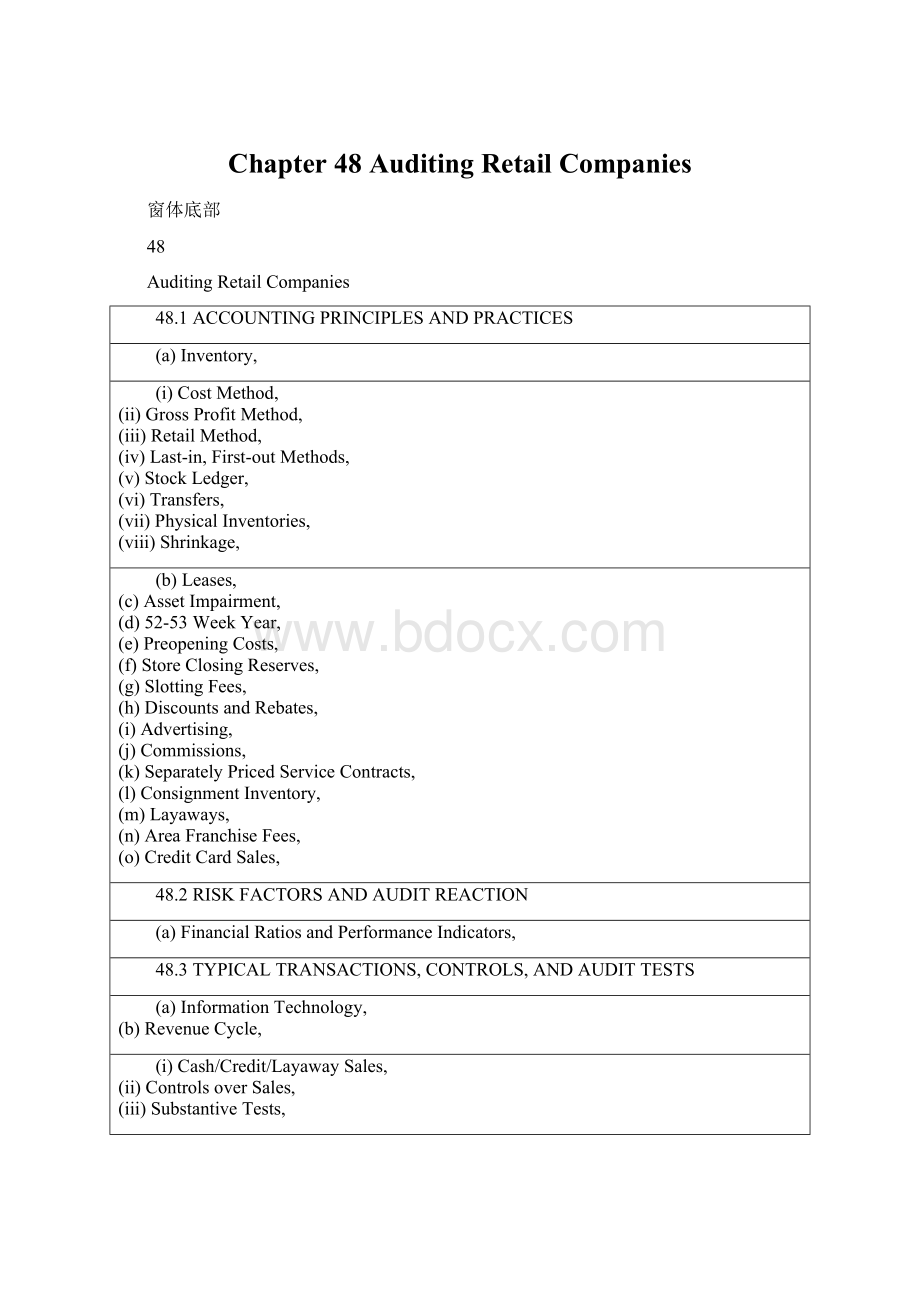Chapter 48 Auditing Retail Companies.docx
《Chapter 48 Auditing Retail Companies.docx》由会员分享,可在线阅读,更多相关《Chapter 48 Auditing Retail Companies.docx(25页珍藏版)》请在冰豆网上搜索。

Chapter48AuditingRetailCompanies
窗体底部
48
AuditingRetailCompanies
48.1ACCOUNTINGPRINCIPLESANDPRACTICES
(a)Inventory,
(i)CostMethod,
(ii)GrossProfitMethod,
(iii)RetailMethod,
(iv)Last-in,First-outMethods,
(v)StockLedger,
(vi)Transfers,
(vii)PhysicalInventories,
(viii)Shrinkage,
(b)Leases,
(c)AssetImpairment,
(d)52-53WeekYear,
(e)PreopeningCosts,
(f)StoreClosingReserves,
(g)SlottingFees,
(h)DiscountsandRebates,
(i)Advertising,
(j)Commissions,
(k)SeparatelyPricedServiceContracts,
(l)ConsignmentInventory,
(m)Layaways,
(n)AreaFranchiseFees,
(o)CreditCardSales,
48.2RISKFACTORSANDAUDITREACTION
(a)FinancialRatiosandPerformanceIndicators,
48.3TYPICALTRANSACTIONS,CONTROLS,ANDAUDITTESTS
(a)InformationTechnology,
(b)RevenueCycle,
(i)Cash/Credit/LayawaySales,
(ii)ControlsoverSales,
(iii)SubstantiveTests,
(c)PurchasingCycle,
(d)InventoryCycle,
(i)PriceAdjustments,
(ii)RetailMethod,
(iii)SubstantiveTests,
(e)PayrollCycle,
(f)LeasingCycle,
(g)ArrangementswithVendors,
Retailingisthesellingofgoodstotheultimateconsumer,usuallyinsmallquantities.Retailersvarygreatlyinsize,format,geographicalbase,productmix,sophistication,andtypeofcustomer.Althoughtherearemanywaystocategorizeretailers(forexample,bytypeofcustomerorproductline),oneofthemostusefulwaysforpurposesofunderstandingtheirbusinessprocessesistoclassifythemaccordingtowhethertheyarestore-basedordirectresponseretailers.Store-basedretailersincludedepartmentstores,supermarkets,warehousestores,homecenters,outlets,anddrugstores-anyretailerthatsellsmerchandisefromaphysicallocationwhereconsumerscometopurchaseproducts.Directresponseretailersincludecatalogmerchants,cabletelevisionhomeshoppingservices,andcomputer-basedshoppingservices.Theseretailersdonothaveface-to-facecontactwiththeircustomers.Manyretailersoperateinacombinationoftheseformats.
48.1ACCOUNTINGPRINCIPLESANDPRACTICES
(a)Inventory
Oneoftheprimaryareasoffocusforaretailentityismerchandiseinventory.Severalinventoryaccountingmethodsareusedintheretailindustry.
(i)CostMethod.Thecostmethodtrackssalesandcostsbyspecificstockkeepingunits(SKUs).Thismethodcanbeburdensomewithoutacomputersystembecauseindividualcostrecordsmustbekeptforeachitem.Historically,thismethodwaspracticalonlyforretailoperationsthatcarriedalimitednumberofSKUs,suchasjewelrystores,furnituredealers,andconsumerelectronicsandapplianceretailers.However,ascomputersystemsbecamemoresophisticated,thecostmethodhasbecomeincreasinglypracticalevenforretailerswithmanySKUs.Accountingcontrolunderthecostmethodisbasedonacumulativerecordofcostfigures.
(ii)GrossProfitMethod.Thegrossprofitmethod,usedbysomeretailers(oftendrugandconveniencestorechains),isanestimatingtechniqueinwhichcostofgoodssoldiscalculatedusinganestimatedcostpercentagethatiscomputedas1-theestimatedgrossprofitpercentage.Therearetwowaysofestimatingthecostpercentage.Oneistocountarepresentativesampleofitemsthatarevaluedatbothcostandretail;theinventoryatcostisdividedbytheinventoryatretailtocomputethecostpercentage.Theotherwayofestimatingthecostpercentageistousegrossprofitregisterstorecordallsalesatbothcostandretail.(Theuseofgrossprofitregistersrequiresthatallstoreinventorybecostcoded.)Toarriveattheamountofinventoryonhand,theretailerfirstdeterminesthecostofgoodsavailableforsalebyaddingthecostofbeginninginventorytothecostofcurrent-periodpurchases.Then,salesfortheperiodaremultipliedbytheestimatedcostpercentagetoarriveatestimatedcostofgoodssold.Thedifferencebetweenthetwocalculationsistheestimatedinventoryonhand.Whenretailersusethegrossprofitmethod,itisimportantthatphysicalinventoriesbetakenatornearyear-endtoadjustthebookinventorytoactual.
Thegrossprofitmethodisparticularlyusefulinestimatingcostofgoodssoldandinventoryforinterimreportingpurposes.Thereare,however,anumberofdisadvantagestoitsuse:
1.Theestimatedgrossprofitmaybedistortedbecausethemixofproductsactuallysoldduringtheperiodmaybedifferentfromthemixusedtocalculatetheestimatedgrossprofitpercentage.
2.Theestimatedgrossprofitpercentagecanbechangedtomanipulategrossprofitsanddistortinterimresults.
3.Theamountofinventoryshrinkage(discussedlaterinthechapter)cannotbedeterminedbecausepartofitmaybecausedbyaninaccurategrossprofitpercentage.
Grossprofitcannotbedeterminedaccuratelyuntilacompletephysicalinventoryatcostistakenattheendoftheperiodandappropriateadjustmentstobookendinginventoriesaremade.
(iii)RetailMethod.Theretailmethodisthemethodmostcommonlyusedbystore-basedretailers.Itwasdevelopedinresponsetothedifficultyofcostingindividualitems.Intheretailmethod,purchasesandsalesarerecordedatretailprices,pricechangesarerecognizedatretailprices,anestimatedvalueforendinginventoryiscalculatedatretail,andthenendinginventoryisconvertedfromretailpricetocost.Theretailmethodrequiresthatallchangesinsellingpricesbeaccountedfor.
Theretailmethodisanaveragingmethodusedwithreasonablyhomogeneousinventorygroupings,inwhichtheretailerestablishestherelationship,generallybydepartment,betweengoodsavailableforsaleatcostandatretail.Usingthisrelationship,theretailerderivesacostmultiplier,whichisusedtoconverttheperiod-endinventoryfromretailtocost.Becausethisisanaveragingmethod,consistencyingrossprofitpercentageswithinadepartmentisimportanttoavoidskewingthecostmultiplierasaresultofchangesinthedepartmentalitemmix.Propertreatmentofmarkupsandmarkdownswillresultininventorystatedatthelowerofcostormarket,whichisrequiredregardlessoftheaccountingmethodused.
Theretailmethodhasseveraladvantages,includingprovidingperiodicinventoryandcostofgoodssoldcalculationswithoutaphysicalinventory.Whenphysicalinventoriesaretaken,theycanbepricedatretailonly.Becausetheretailmethodisaperpetualmethod,itcanbecomparedwithphysicalcountsandtheamountsofshortagescanbedetermined.
Figure48.1illustratesthecalculationofendinginventoryatthelowerofcostormarketusingtheretailmethod.
Figure48.1RetailMethodCalculation
Calculation
Description
Totalmerchandisehandled
Componentsoftotalmerchandisehandled:
Cost
Retail
Openinginventory
$60,000
$100,000
∙Openinginventoryatcostandretail
Purchases
30,000
50,000
∙Purchasesatcostandretail(costincludesinvoicecost,freight-in,andadditionalcapitalizedcosts)
Markups,netofmarkupcancellationsof$3,000cancellations
10,000
∙Markupsnetofanymarkup
Totalmerchandisehandled
$90,000
$160,000
Cumulativemarkonpercentage
43.75%
Cumulativemarkondividedbyretailtotalofmerchandisehandled:
($160,000-$90,000)÷$160,000
Costmultiplier
56.25%
Complementofthecumulativemarkonpercentage:
100%-43.75%=56.25%
Canbecalculatedbydividingtotalcostbytotalretail:
($90,000÷$160,000)
Inventoryreductions
Componentsofinventoryreductions:
Sales,net
$28,000
∙Sales
Salesdiscounts
1,120
∙Salesdiscounts
Markdowns,netofmarkdowncancellationsof$2,000
3,920
∙Markdownstakenandmarkdowncancellationstorestoretemporarypricereductions
Shrinkage
560
∙Estimatedvalueofbookinventoryinexcessofactualphysicalinventory
Totalofinventoryreductions
$33,600
Endinginventoryatretail
$126,400
Differencebetweentotalmerchandisehandled(atretail)andtotalinventoryreductions(atretail):
$160,000-$33,600=$126,400
Endinginventoryatlowerofcostormarket
$71,000
Conversionofretailpriceofinventorytolowerofcostormarket.Productofmultiplyingendingretailinventorybycostmultiplier:
56.25%´$126,400=$71,100
(iv)Last-in,First-outMethods.Last-in,first-out(LIFO)methodsmatchthemostrecentcostsofpurchasesagainstcurrentrevenues.LIFOmethods,includingretailLIFO,typicallyusedbyretailersaredollarvalueLIFOmethods.WhenretailLIFOisusedinconnectionwiththeretailmethodofvaluinginventories,inventoryincrementsordecrementsaremeasuredinretaildollars.(OtherdollarvalueLIFOmethodsmeasureincrementsordecrementsatcost.)LIFOtypicallyischosenbyretailersbecauseoftaxbenefitsobtainedduringperiodsofpriceandinventorylevelincreases.IfLIFOisadoptedfortaxpurposes,italsomustbeusedforfinancialreportingpurposes.TherearedisadvantagestotheLIFOmethod,includingasignificantlyincreasedrecord-keepingburdenandreducedearningsandinventoryvaluesinperiodsofrisingprices.Alternatively,deflationorlowerinventorylevelscanincreasetaxableincome.
(v)StockLedger.Thestockledgeristheprimaryrecordusedtorecordandvalueinventories.Theledgermaybemaintain